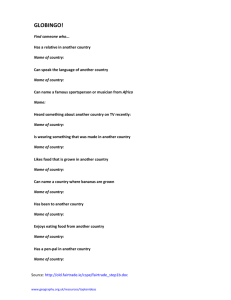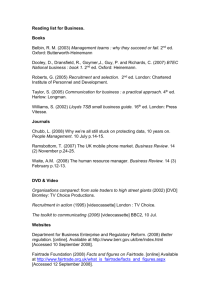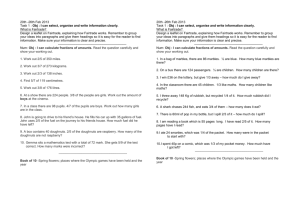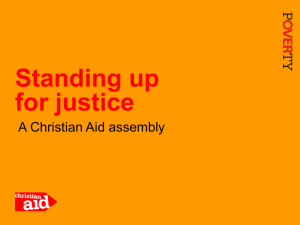Fairtrade Cotton Certification Mark Manual International Sales
advertisement
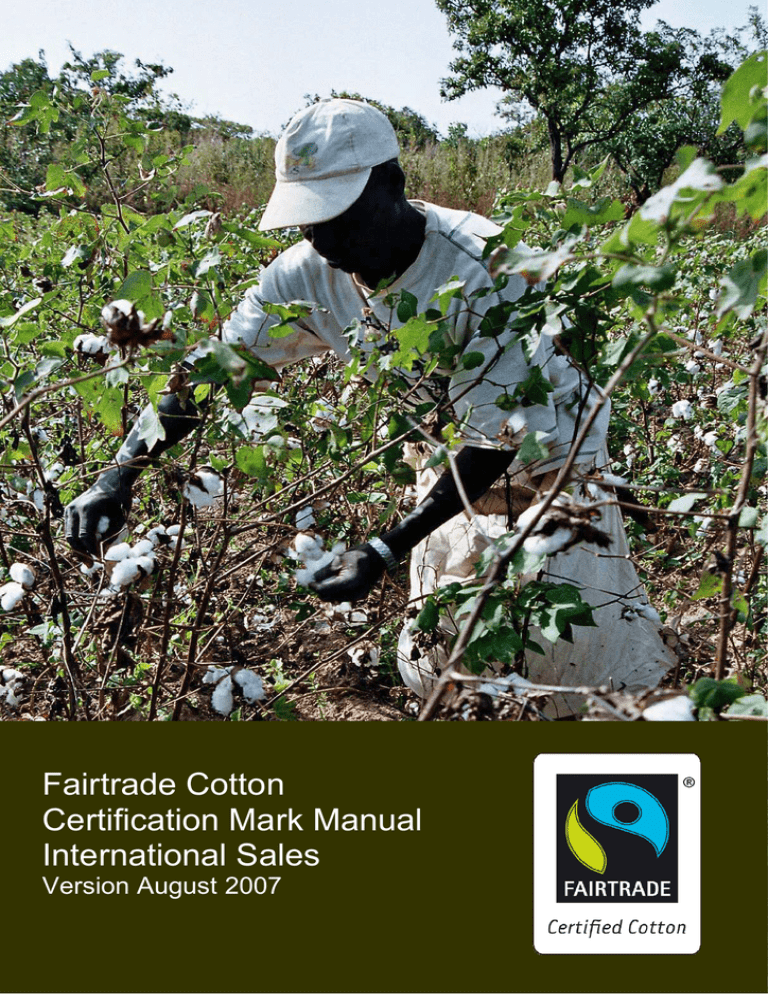
Fairtrade Cotton Certification Mark Manual International Sales Version August 2007 INTERNATIONAL FAIRTRADE CERTIFICATION MARK Manual for International Sales Version August 2007 CONTENT A. GENERAL INFORMATION Page 3: Introduction, Mission, Goal, Values, Meaning, Property, Abuse Page 4: Approval Process, Mark Supervision, Contact Details B. GENERAL GUIDELINES FOR THE CM USE Page 5: Principles of CM Use, Logo Architecture Page 6: Primary Logotype, Page 7 : Colour Page 8: White Border, Exclusion Zone Page 9: Size, ® Page 10: Relationship with Brand, Application of Cotton Fairtrade Mark Page 11: Composite Products, Page 12: Statements and Claims, Minimum Text Copyright Cover Image 2007 Max Havelaar-Stiftung (Schweiz) 2 A GENERAL INFORMATION 1. INTRODUCTION This Manual is for licensees selling in more than one country, but may also provide useful practical guidance to licensees only selling in their home markets. The International Fairtrade Certification Mark (CM) is now being used by a very large amount of stakeholders worldwide, its recognition and value increasing each year. The purpose of this document is to keep the same Corporate Identity for labelled Fairtrade wherever the CM is presented to a wider public. 2. MISSION To strengthen developing countries producers’ position in the market place through an international consumer product label. 3. GOAL OF CERTIFICATION MARK To establish the certificate of Fairtrade as a leading standard for consumer choice. 4. VALUES Authoritative, incorruptible, enthusing, trustworthy, ethical, valuable 5. MEANING BEHIND THE MARK Previous Fairtrade labels merged into the shape of a cheering person representing the people, both consumers and producers, behind Fairtrade. Fresh, positive colours have been chosen to accompany the symbol, in line with the modern and positive image the Fairtrade movement aims for, where producers and consumers are brought closer together through an act of production and consumption of Fairtrade labelled products. Its abstract character was purposely chosen to be “multi-cultural” and “future-proof”. 6. PROPERTY INTERNATIONAL FAIRTRADE CERTIFICATION MARK The International Fairtrade Certification Mark (CM) is the exclusive property of Fairtrade Labelling Organizations International FLO, and internationally registered as a trademark (for EU with no. 002606994; at the World Intellectual Property Organisation (WIPO) with no. 806 431). 7. ABUSE FLO reserves the right to take legal action against any party that reproduces or copies the Certification Mark in any form whatsoever without the prior authorization of FLO or an LI. Please notify FLO of any abuse of the Fairtrade Mark as protecting its integrity is paramount. 3 8. APPROVAL PROCESS FLO has licensed the CM to Labelling Initiatives (LIs) to sublicense it for Fairtrade Certified Products in Home country. Procedures for Crossborder Sales can be obtained from the LI in your home country (Home LI). If the packaging is created according to the regulations in this manual, it will be acceptable in all Destination LI markets, except for the USA. The permission to sell in these countries, the license, however, still needs to be obtained from your Home LI. A colourfast packaging proposal must be made available by the Licensee to the Home LI who will approve international packaging for all destination countries. Consultation well in advance is recommended. The Licensee will notify the Home LI in good time of any Licensee-initiated promotional materials, and present them for approval. By this the Destination LI has the opportunity to withhold approval of the promotional activities, should their implementation have the potential to prejudice/damage the CM or the Home and Destination LI. 9. CONTACT DETAILS The Labelling Initiatives should be the first point of contact for any parties within their countries. You can find their contact details at www.info.fairtrade.net FLO’s contact is: Fairtrade Labelling Organizations International eV Bonner Talweg 177 53129 Bonn, Germany Tel: +49-228 949 230 Fax: +49-228-242 1713 E-mail: cm@fairtrade.net www.fairtrade.net 4 B GENERAL GUIDELINES FOR USE OF THE INTERNATIONAL FAIRTRADE CERTIFICATION MARK (FOR PACKAGING AND PROMOTIONAL MATERIALS) 1 PRINCIPLES OF THE CM USE The purpose of the Certification Mark is to clearly identify and promote Fairtrade Certified products. The guiding principles when assessing material should therefore be to ensure that: a. The CM is our asset, has a high moral and financial value and must be presented accordingly. b. The CM represents our entire certification system and its application is the end purpose of the entire Fairtrade certification process. c. The CM allows consumers to identify Fairtrade-Certified products. d. The CM must therefore not be associated with any other brand, Mark or identity. e. The CM must not be associated with products that have not been Fairtrade-Certified. 2 LOGO ARCHITECTURE a. This is the logo architecture. For any reference to Fairtrade Certified Cotton, whether in promotional materials or on packaging, only the Cotton Fairtrade Mark, as presented in figure 1, may be used. b. The international version of the Cotton Fairtrade Mark, will be accepted on international packaging in all LI countries, except for the USA (see the label for the US in figure 3). In Switzerland the international label will be accepted from 1.3.2008. c. If the main market of a product is in Switzerland, the Netherlands, Belgium and France the licensee is required to use the international version of the logo with the “Max Havelaar” strapline (see figure 2). The artwork can be obtained from the relevant LIs. 1. 2. d. This manual does not apply to the mark of the US Fairtrade Labelling Initiative (fig 3), but only to the International Fairtrade Certification Mark (fig. 1). The International Cotton Fairtrade Certification Mark can be obtained from an LI or FLO. 3. USA 5 3 PRIMARY LOGOTYPE a. This is the logotype for Fairtrade Certified Cotton (figure 4). The Cotton Fairtrade Mark consists of the standard Fairtrade Certification Mark, depicting the graphic element of the “cheering person” on a circular background, enclosed by a black vertical rectangle with the word element FAIRTRADE, surrounded by a white frame and the words “Certified Cotton”. The CM must never be redrawn or altered in any way (see figures 5 to 8). 4. Primary logotype The CM colours must never be altered (see figures 9 and 10) and the word Fairtrade must never be removed (see figures 10 and 11). The words “Certified Cotton” must always be included (see figure 12). The CM must always be depicted in an upright position and not tilted to any degree (see figure 13). 5. Round, not in black rectangle, green, wrong font 6. No Fairtrade, red 7. No Fairtrade, red, no border 8. Rounded edges on inner logo 9. Red 10. Blue, no Fairtrade 11. Right colours, no Fairtrade 12. No “Certified Cotton” 13. Don’t tilt 6 The spatial relationship, the font type and the relative size as well as the spacing of the font must not be altered. The word “Fairtrade” must be spelled as one word (see figures 14 and 15). No parts of the CM may be cut out or integrated into other designs (see figures 16 and 17). No other brands are to be incorporated into the CM’s design (see figures 16 to 18). 16. Wrong colours, wrong font, own brand added 14. Wrong spelling, wrong font, wrong spatial relation 15. Wrong spelling, wrong font 18. Right colours but own brand added 17. No double line, wrong font, own brand added, no Certified Cotton 4 COLOUR This full colour version (as seen in figure 4 above) is recommended. Grass Pantone 382 C30 M0 Y94 K0 R162 G201 B0 HTML A2C900 Sky Pantone 306 C76 M0 Y6 K0 R1 G151 B208 HTML 0197D0 White Black C0 M0 Y0 K0 R255 G255 B255 HTML FFFFFF C0 M0 Y0 K1 R0 G0 B0 HTML 000000 7 Where colour restrictions apply, this black and white version of the logo (figure 19) can also be used. It is recommended to use coated paper and the ‘Pantone coated’ colours. The colours “Grass” and “Sy”, as specified above, may not be used in the brand name or packaging. When printed, it must be ensured that the colours look distinct, as sometimes this is not noticed electronically, but only after printing. It is recommended to use colours as distinct as possible from the Fairtrade colours, thereby ensuring that the CM is clearly distinct from the brand. 19. Black and white 5 WHITE BORDER On dark or mid/tone backgrounds (see figures 20 and 21) the cotton graphic must be used without a black border. The graphic with the frame should only be used on white or light backgrounds (figures 22 and 23). The black border must especially be used when applying the Mark on a white background (figure 24). 20. 22. 21. Mark must not have a border on dark backgrounds 24. White on white must have a black border 23. 6 EXCLUSION ZONE Do not let any text touch the CM or come within its exclusion zone to ensure the CM remains uncluttered. The exclusion zone equals the size of the word FAIRTRADE (Marked as “X” in figure 25). 25. Exclusion zone 8 It is recommended to leave an exclusion zone between the CM and prominent individual graphics. This does not apply to background patterns. In the hang-tag shown below in figure 26, the pattern functions as background and is not a prominent graphic. In figures 27 and 29, however, the CM is infringed upon by the graphic of the flowers and the socks “sticking to it”.). The solutions seen on figures 28 and 30 are correctly applied. Figure 26. Figure 27. Figure 29. 7 Figure 28. Figure 30. SIZE On packaging, the recommended size for the Cotton Fairtrade Mark is 17mm wide (the standard Certification Mark inside then has a width of 13.5mm). In order to ensure that the brand of the product is more prominent than the CM, a smaller width of the CM can also be applied on small packaging, with prior approval of the LI. The maximum width is 42 mm. The CM must always be smaller than 20% of the total area of the pack face. 8 ® - REGISTERED SYMBOL To underline the legitimacy of the CM, FLO or the LI can provide graphics with a black ® as seen in figure 31. Figure 31 9 9 RELATIONSHIP WITH BRAND The Certification Mark must not be confused with the brand of the company or organisation and should form a clearly autonomous feature of the material. The CM should therefore always be less prominent than the brand (see figures 26 and xx). In order to avoid confusion, the name “Fairtrade”, the name of an LI (see figure 18) nor the Colours (grass and sky) of the CM, as specified in the colours section, must not be included in the brand name of the product or packaging. When assessing the visual relationship, the overall impression is the most important. Even aspects of the colours, the brand name, the font, the proportions that may be allowed can still lead to an overall impression that the brand/packaging has been created by Fairtrade (FLO/LI). This is absolutely unacceptable, also for legal reasons. If questions arise, please consult your Labelling Initiative. 10 APPLICATION OF THE COTTON FAIRTRADE MARK Packaging: visible at point of sale The Cotton Fairtrade Mark must be on the product when the consumer buys it. This can be either on the product itself (also permanently, eg sewn-in), but also as temporary packaging or label, like eg a swing-tag or wrapper. There is no requirement to place the Certification Mark on the product permanently. The CM must be applied on the front of the packaging. On round packaging, the logotype must be clearly visible when viewed from the front, for instance when on a shelf. If a pack has more than one front face, the Mark should appear on all relevant sides. When the product is within a shelf tray or box, the CM should still be visible. In order to strengthen its appearance as a Certification Mark (and not let is appear as a brand), it is recommended to position the CM near the edge and corners of the packaging, however maintaining the exclusion zone. Application on the outside of the product: only with a company brand In case the CM is applied directly on the outside of a product, there always needs to be a brand in order to distinguish between the brand/manufacturer and the Certification Mark. The distinction needs to be very clear. If the Cotton Fairtrade Mark is applied to the outside of the product, then it needs to be applied as a tag (see figures 32 to 35), and must not be embroidered or printed directly onto the product (figure 36). Figure 32 Figure 33 Figure 34 10 Figure 35 Figure 36 Figure 37 Application on the inside of the product It is optional to have a CM on the inside of the product (figure 37). It is also possible to just place text, like “Fairtrade Certified Cotton” on the inside. Be aware: Licensees need to check relevant labelling legislation, as composition labels have defined terms and often don’t allow an additional statement next to “Cotton”. So eg, you might not be able to say 80% Fairtrade Cotton 20% Polyester 11 COMPOSITE PRODUCTS In case of composite products, it is mandatory to state the percentage of Fairtrade components and which individual components are Fairtrade Certified (in this case, only cotton), as in figures 38 and 39. Further details on which composite products are allowed to carry the CM can be found in the Composite Products Regulations, obtained from your LI. Figure 38 Figure 39 11 12 STATEMENTS AND CLAIMS Text that implies more than the Mark guarantees, that misleads consumers about the Mark or Fairtrade Standards, or which may have the effect of devaluing the Mark, is not acceptable. In the copy, there shall be no statements about the CM that imply product quality claims. The guiding principles should be applied to avoid confusion. It needs to be very clear that it is the cotton that is Fairtrade Certified and not the whole textile, nor the company itself. Here are some examples of what can be acceptable and what not: Products YES: NO: Jeans made of Fairtrade Certified Cotton Fairtrade Jeans Textiles made with Fairtrade Certified Cotton Fairtrade Textiles This Denim has been made from Fairtrade Cotton Fairtrade Denim The cotton in these jeans is Fairtrade Certified. Fairtrade Cotton Jeans Company claims YES: NO: We offer Fairtrade Certified Cotton Products! We are Fairtrade Certified. Ask for our products made of Fairtrade Cotton! We dye and knit Fairtrade Cotton. (Company name) is a Fairtrade manufacturer. 13 MINIMUM TEXT Unless agreed otherwise, it is compulsory to print the minimum text in at least one language, preferably English, plus the website www.info.fairtrade.net on the package. The first sentence is compulsory; the second sentence is optional. Language Cotton Minimum Text Afrikaans Die Fairtrade Sertifiserings Merk is U onafhanklike waarborg dat die katoen in hierdie produk teen internasionale Fairtrade Standaarde gesertifiseer is. Met die koop van hierdie produk ondersteun U die verbetering van werks-en-lewensomstandighede van katoen produsente en die beskerming van die natuur in ontwikkelende lande. Chinese/ Mandarin 公平貿易標籤是你的獨立保証,確保持有此標籤的棉花得到國際公平貿易標準認可。 購買此公平貿易棉花可改善發展中國家生產者的工作及生活環境,同時亦能幫助保護環 境。 12 Danish Dutch English Estonian Finnish French German Greek Icelandic Italian Japanese Fairtrade/Max Havelaar-mærket er din uafhængige garanti for at bomulden i dette produkt er certificeret efter internationale Fairtrade standarder. Dit køb af dette produkt, som er fremstillet med Fairtrade-certificeret bomuld, er med til at forbedre arbejds- og levevilkårene for nogle af verdens fattigste bomuldsproducenter, samt at fremme miljøbeskyttelse. Het onafhankelijk Fairtrade / Max Havelaar Keurmerk garandeert u dat de katoen in dit product gecertificeerd is volgens de internationale Fairtrade handelsvoorwaarden. Door het kopen van dit product, gemaakt met Fairtrade gecertificeerde katoen, draagt u bij aan betere leef- en werkomstandigheden van katoenboeren in ontwikkelingslanden en ondersteunt u bescherming van het milieu. The Fairtrade Certification Mark is your independent guarantee that the cotton in this product has been certified in accordance with international Fairtrade Standards. The purchase of this product made with Fairtrade Certified Cotton enables the improvement of working and living conditions of Cotton Producers in developing countries and encourages environmental protection. Fairtrade märk tagab, et selle toote puuvill on toodetud vastavalt rahvusvahelistele Fairtrade standarditele. Selle toote ostuga parandad puuvillatootjate töö- ja sotsiaalseid tingimusi ja keskkonda arengumaades. Reilun kaupan sertifiointimerkki on takuu siitä, että tämän tuotteen puuvilla on sertifioitu kansainvälisten Reilun kaupan kriteerien mukaisesti. Reilu kauppa sertifioidusta puuvillasta valmistetun tuotteen ostaminen parantaa kehitysmaiden puuvillan viljelijöiden työ- ja elinoloja kehitysmaissa ja edesauttaa ympäristön hyvinvointia. Le label indépendant Fairtrade / Max Havelaar vous garantit que le coton de ce produit a été certifié selon les standards internationaux du commerce équitable. En achetant ce produit contenant du coton certifié Fairtrade, vous contribuez à l’amélioration des conditions de vie et de travail des producteurs de coton de pays en voie de développement, et vous encouragez le respect de l’environnement. Das unabhängige Fairtrade-Siegel gibt Ihnen die Sicherheit, dass die Baumwolle in diesem Produkt nach den internationalen Fairtrade-Standards zertifiziert wurde. Mit dem Kauf dieses Produktes mit Fairtrade-Baumwolle leisten Sie einen Beitrag zur Verbesserung der Lebens- und Arbeitsbedingungen von Baumwollproduzenten in Entwicklungsländern und zur Förderung des Umweltschutzes. Το Σήµα Συµµόρφωσης Fairtrade είναι η ανεξάρτητη εγγύησή σας ότι το βαµβάκι σε αυτό το προϊόν πιστοποιήθηκε σύµφωνα µε τις διεθνείς προδιαγραφές της Fairtrade. Η αγορά αυτού του προϊόντος καθιστά δυνατή τη βελτίωση των συνθηκών εργασίας και διαβίωσης των παραγογών βαµβακιού σε αναπτυσσόµενες χώρες και ενθαρρύνει την προστασία του περιβάλλοντος. Fairtrade-vottunarmerkið tryggir að bómull í þessari vöru hafi fengið vottun samkvæmt alþjóðlegum Fairtrade-stöðlum. Með því að kaupa þessa vöru úr Fairtrade-vottaðri bómull tekur þú þátt í að bæta vinnu- og lífskjör bómullarræktenda í þróunarlöndum og ýtir undir umhverfisvernd. Il marchio indipendente Fairtrade garantisce che il cotone di questo prodotto è stato certificato secondo gli standard internazionali del Commercio Equo. L'acquisto di questo prodotto fatto con cotone certificato Fairtrade permette il miglioramento delle condizioni di vita e di lavoro dei produttori di cotone nei paesi in via di sviluppo e favorisce la protezione dell'ambiente. フェアトレード認証商標はこの製品の原材料であるコットンが国際フェアトレード基 準に従い認定を受けたものであることを保証するものです。この商品の購入は、発展 Norwegian 途上国のコットン生産者の労働条件と生活状況の改善および環境保全を促進します。 Fairtrade -merket er din uavhengige garanti for at bomullen i dette produktet er sertifisert etter internasjonale-standarder for Fairtrade. Ditt kjøp fører til bedre arbeidsvilkår og tryggere sosiale forhold for småprodusenter og arbeidere i noen av de fattigste deler av verden. Samtidig bidrar du til å beskytte miljøet. 13 Portuguese Russian Spanish Swedish Vietnamese O selo de certificação FAIRTRADE é a sua garantia independente de que o algodão deste produto foi certificado conforme os Critérios Universais do Comércio Justo. A compra deste produto, feito com algodão certificado Fairtrade, permite a melhora das condições de trabalho dos pequenos produtores de algodão e ajuda a preservar o meio ambiente. Сертификационная марка Fairtrade ("честная торговля")- ваша независимая гарантия, что хлопок в этом продукте был сертифицирован в соответствии с международными стандартами Fairtrade. Приобретение этого продукта, сделанного из Fairtrade сертифицированного хлопка, позволяет улучшить условия работы и жизни хлопковых производителей в развивающихся странах и поощряет защиту окружающей среды. El Sello FAIRTRADE es la garantía independiente de que el algodón de este producto ha sido producido conforme a los estándares internacionales del Comercio Justo.La compra de este producto, elaborado a base de algodón procedente de Comercio Justo Certificado, posibilita la mejora de las condiciones de trabajo y de vida de los Productores de Algodón en los países en vía de desarrollo y fomenta la protección del medio ambiente. Fairtrade/Rättvisemärkt garanterar att bomullen i denna produkt är certifierad i enlighet med internationella Fairtrade-kriterier. När du köper Rättvisemärkt bidrar du till bättre arbets- och levnadsvillkor för bomullsproducenter i utvecklingsländer – en bättre framtid för människa och miljö. Nhãn Thương Mại Công Bằng (Fairtrade) là đảm bảo uy tín rằng bông vải trong sản phẩm được dãn nhãn đã được chứng nhận theo Tiêu chuẩn quốc tế về Thương Mại Công Bằng. Khi mua các sản phẩm làm từ Bông vải được chứng nhận Thương Mại Công Bằng, bạn đã góp phần nâng cao điều kiện lao động và điều kiện sống của người sản xuất bông vải tại các nước đang phát triển và khuyến khích việc bảo vệ môi trường. 14
